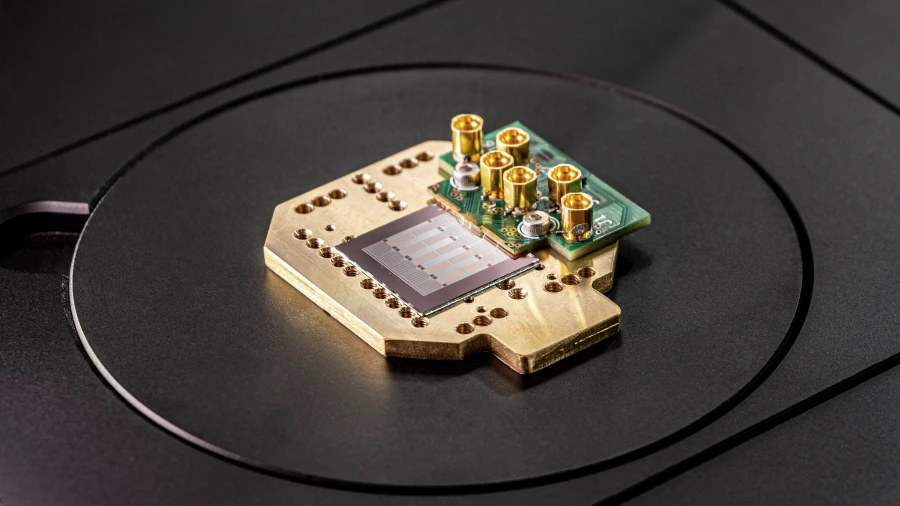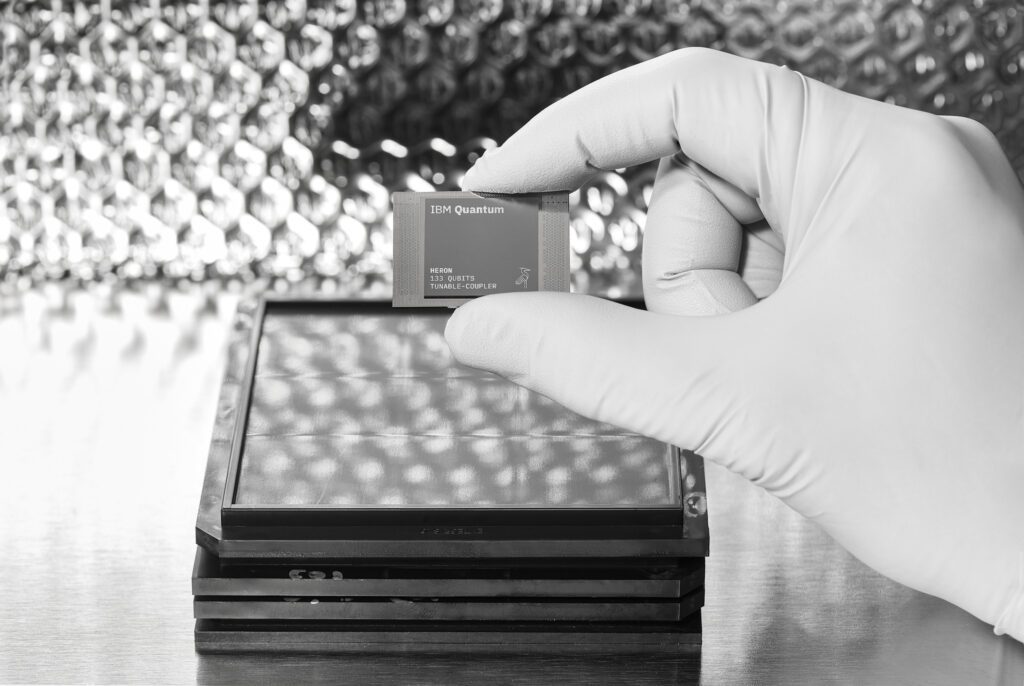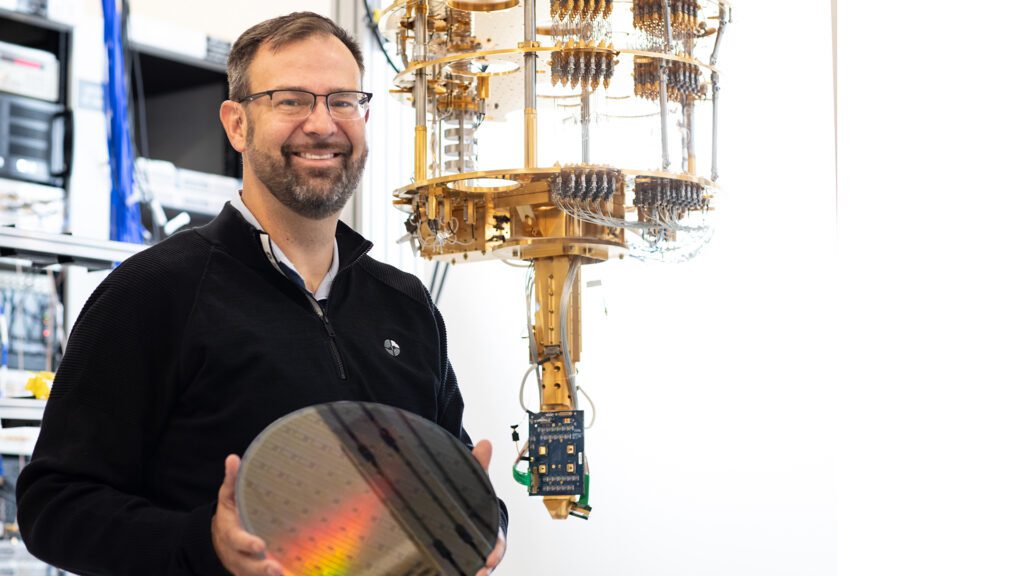Artificial Intelligence
Future Telecoms
Quantum
Future telecoms 2025 to 2026: from faster networks to thinking infrastructure
Reading time: 7 mins
What are Google, Microsoft, IBM, Intel, Amazon, and Nvidia up to in the quantum computing industry?
Interest in quantum technology spiked in 2024, with an Omdia survey revealing that 39% of quantum computing vendors expected customers to start using their technology in an operational setting by 2026.
This optimism was driven by a number of key breakthroughs, such as IQM achieving 99.9% fidelity with a 2-qubit gate; very close to what’s required for fault-tolerant quantum computing (FTQC). This was then followed by Google launching its superconducting quantum chip, Willow.
However, the world of quantum computing also received a reality check (and a stock market shock) at the start of 2025, when Nvidia CEO Jensen Huang claimed that a “very useful quantum computer” was at least two decades away.
“If you kind of said 15 years for very useful quantum computers, that’d probably be on the early side,” Huang said during Nvidia’s financial analyst day at the Consumer Electronics Show. “If you said 30, it’s probably on the late side. But if you picked 20, I think a whole bunch of us would believe it.”It’s worth noting that Huang didn’t qualify what a “very useful quantum computer” was, and many quantum computing companies were unimpressed with his statement, with Alan Baratz, president and CEO at D-Wave Quantum, calling his comments “the latest in a string of misinformation on quantum computing.”
Pure-play quantum computing stocks were hit hard, with Nvidia’s CEO seeming to suggest that big tech companies with a foothold in quantum computing would be a smarter choice for investors (resulting in IonQ, D-Wave, Rigetti, and Quantum Computing Inc. stock all dropping by up to 40% in single-day trading following Huang’s remarks).
“One or more of these hungry quantum upstarts may indeed become major players in the long run… But I wouldn’t bet on any of these market darlings right now,” explains Anders Bylund from The Motley Fool. “Alphabet and IBM, on the other hand, are already old hands with very profitable core businesses, which gives them the luxury of developing tomorrow’s most mind-blowing technology as an experimental side gig.”
With the resources available to big tech companies, they will obviously be better placed to weather any future stock market storms, and – whether successful or not – their strategies will have a significant impact on the direction of travel for quantum computing.
In this report we showcase how big tech companies such as Amazon, IBM, Intel, Google, Microsoft, and Nvidia are addressing quantum computing, including how they are also partnering with pure-play companies to broaden their appeal.
A series of exciting quantum announcements in 2024 culminated with Google’s news that its superconducting quantum chip, Willow, could exponentially improve quantum error correction (QEC) – one of quantum computing’s biggest hurdles.
“The more qubits we use in Willow, the more we reduce errors, and the more quantum the system becomes,” explains Hartmut Neven, founder and lead at Google Quantum AI. “We tested ever-larger arrays of physical qubits, scaling up from a grid of 3×3 encoded qubits, to a grid of 5×5, to a grid of 7×7 – and each time, using our latest advances in quantum error correction, we were able to cut the error rate in half. In other words, we achieved an exponential reduction in the error rate.”
Much has also been made of the fact that the Willow chip performed below threshold. In quantum computing, “below threshold” refers to a state where you can drive down errors whilst scaling up qubits, and it’s a key component for developing fault-tolerant machines.
“As the first system below threshold, this is the most convincing prototype for a scalable logical qubit built to date,” says Neven. “It’s a strong sign that useful, very large quantum computers can indeed be built. Willow brings us closer to running practical, commercially-relevant algorithms that can’t be replicated on conventional computers.”With 105 qubits, Willow also boasts an increase when compared to its precursor, Sycamore, which had 67 qubits. And by using its Random Circuit Sampling (RCS) benchmark, Google’s AI team claims that Willow can complete a calculation in just five minutes that would take a supercomputer 10 septillion years, which is 10^25, or 10,000,000,000,000,000,000,000,000 years.
Microsoft kicked off 2025 with the announcement of its Majorana 1 processor, “the first quantum processing unit (QPU) powered by a topological core.” This breakthrough is built upon a novel class of materials termed “topoconductors,” which enable the creation of stable topological qubits. These qubits are designed to be more robust and less error-prone than traditional qubits, according to the company. Meanwhile, the architecture of Majorana 1 allows for the potential integration of up to one million qubits on a single chip, paving the way for practical, large-scale quantum computations.
It’s an interesting development given Microsoft’s stance to date. There are a number of quantum platforms being developed and explored by companies looking to create the first “useful” quantum computer, and each of them comes with a unique set of challenges and opportunities. Microsoft, through its Azure Quantum compute platform, is providing access to multiple types of quantum hardware to enable companies to choose the right technology for specific use cases. Given the nascent market, it’s a practical approach.
“Currently, trapped-ion and neutral-atom systems are demonstrating the best performance when used to create logical qubits using our qubit-virtualisation system,” a spokesperson for the Azure Quantum team tells BI Foresight. “These two qubit types allow for the quantum error correction needed to enable reliable quantum computing.”
Microsoft is backing trapped-ion and neutral-atom systems, which it believes demonstrate the best performance when used to create logical qubits using Microsoft’s qubit-virtualisation system.
“These two qubit types allow for the quantum error correction needed to enable reliable quantum computing,” Microsoft’s spokesperson explains. “We are working with Atom Computing, a neutral atom company, integrating its hardware with the Azure Quantum compute platform. Atom Computing’s machine has over 1,200 neutral atom qubits and the company aims to enable scalable quantum error correction in conjunction with Microsoft’s qubit-virtualisation system.”
The two companies recently announced the creation and entanglement of 24 logical qubits, which will be available in a quantum machine in late 2025, which Microsoft says “will likely be the most powerful commercial quantum computer in the world”. Elsewhere, Microsoft’s partnership with Quantinuum demonstrated the most reliable logical qubits on record, due to the high fidelities and all-to-all connectivity of trapped ion systems.
“This reliability allowed us to solve a real-world chemistry problem – a case study in catalytic reactions producing chiral molecules – using two logical qubits integrated with AI and cloud high-performance computing,” Microsoft’s spokesperson tells us. “The logical qubits allowed us to estimate the ground state energy of the active space of an important catalytic intermediate.
“Neutral-atom quantum computers can also enable the error-correction capabilities required for reliable quantum computing due to their low susceptibility to noise, all-to-all connectivity, and ability to be packed tightly – only microns apart – in arrays held in place by lasers and manipulated with pulses of light.”
Microsoft’s Azure Quantum team has now generated logical qubits from neutral atoms and is optimising the system to enable reliable quantum computation and produce what it hopes will be the world’s most powerful quantum machine on record. The company has also developed the Q# programming language, designed for quantum computing, and which integrates with the Azure quantum development kit (QDK).
Microsoft is also looking at light-based solutions for networking, and is working with Photonic, which recently met a critical requirement for long-distance quantum communication. And in May 2024, Microsoft and Photonic successfully performed a teleported CNOT gate between qubits physically separated by 40 metres, demonstrating remote quantum entanglement between T-centres.

IBM has been leading quantum computing development since 2016, when it revealed the world’s first cloud-based quantum computer: the IBM Quantum Experience, providing public access to a five-qubit quantum processor. Further milestones were hit, and then surpassed. And by 2023 IBM had developed Condor, its first quantum processor with more than 1,000 qubits (boasting 1,121 superconducting qubits).
Condor showcased how IBM could increase superconducting qubit density, but it was principally experimental and symbolic. However, alongside the Condor processor IBM also introduced Heron, a quantum processor featuring 133 fixed-frequency qubits, and it’s Heron that has gone on to form the foundation for IBM’s updated hardware roadmap.
“In 2020 we debuted our development roadmap, which laid out our plan for scaling quantum technology through 2023. It set us on course to deliver a chip with over 1,000 qubits in just three years, and introduced the software and services needed to run applications on quantum systems towards frictionless use,” says Jerry Chow, IBM fellow and director of Quantum Systems & Runtime Technology.
“We also laid theoretical groundwork for a capability that will eventually make quantum computers even more powerful: practical quantum error correction with a new efficient code. These advances formed the foundation of a new, more detailed roadmap extending to 2033,” Chow explains.

In 2024, IBM’s Heron chip was capable of running 5,000 gates, and the company says that by focusing on advances in quantum error correction it will launch IBM Quantum Starling by 2029, which should be capable of running circuits with 100 million gates on 200 logical qubits.
These advances have been made possible by combining IBM hardware with its Qiskit research tool, which provides an open-source, Python-based software development kit (SDK), library, and framework to program quantum computers. And in early 2024 IBM launched the Qiskit SDK 1.0, its first, stable, high-performance Qiskit release.
“Now, as we move further into the era of utility, Qiskit has to expand to the complete platform of tools that enable you to extract utility from quantum systems,” Chow says. “By 2033, we expect to see general-purpose quantum computing libraries designed for a wide variety of quantum applications… The utility era is here, and it’s already time to explore business and scientific value with quantum computers today.”
As a global leader in semiconductor fabrication, Intel Labs has opted to pursue the development of silicon spin qubits, with the integration of cryogenic control electronics. This is noteworthy, as it means that Intel can use its existing 300-millimetre CMOS manufacturing techniques to develop quantum computers, too.
“Intel’s qubits are different from other approaches in the industry,” says James Clarke, director of Quantum Hardware at Intel. “While Intel isn’t the only company working on silicon qubits, we’re the only company using the same process line to make our qubits as we do our leading-edge logic technology.”
This gives the company a huge advantage over its competition. However, the company is being cautious about when “quantum practicality” could be reached.
“Despite very exciting developments in the field, a fault-tolerant one million-plus qubit machine and true commercial uses for quantum computing are 10 to 15 years from reality. And that’s to achieve quantum practicality – the point at which quantum computers achieve commercial relevance by doing something significant to change our lives,” says Clarke.
“Instead, the question should not be focused on when we reach commercialisation but on whether some sort of quantum advantage is possible using devices with 50 to a few hundred qubits and what that technology looks like.”

Tunnel Falls is Intel’s most advanced silicon spin qubit chip to date (featuring 12 qubits), and it was made available to the quantum research community in 2023. At that point, Intel claimed that the successor to Tunnel Falls would be available in 2024; however, this didn’t happen. And so 2025 should be the year that Intel announces its next advancement in quantum computing.
“If we build silicon spin qubits on silicon wafers and develop a qubit technology that looks like a transistor, we can follow Moore’s Law of acceleration to build a large-scale system,” explains Clarke. “And while it’s taken several years to translate a prototype in the lab into a fab process, we are getting there.”
Amazon has chosen to take a hardware-agnostic approach to quantum computing, instead focusing on the development of its Amazon Braket service, which is fully integrated into Amazon Web Services (AWS), and enables customers to build, test, run, and analyse results, using different types of quantum computers and simulators.
At the end of 2024 Amazon Braket partnered with Nvidia to integrate the CUDA-Q platform, which allows for hybrid quantum-classical computing workflows.
This collaboration aims to address the role of classical computing in the quantum stack and optimise performance with the limitations of current quantum processors.
In a blog post announcing the partnership, Amazon said that its customers could now develop hybrid workflows using the open-source Nvidia CUDA-Q Platform directly within their Braket developer environment. As a result, the native CUDA-Q simulator running within Braket can offer significantly faster runtime performance than leading open-source simulators.
“They can then test their programs using simulators that run on powerful GPUs within Amazon Braket Hybrid Jobs,” Amazon says. “Best of all, customers can now execute their CUDA-Q programs on all the quantum hardware backends supported by Braket, like the gate-based processors from IonQ, IQM, and Rigetti, and the analog quantum hardware from QuEra, simply by changing a single line of code.”
“The convergence of critical technologies – photonics, quantum computing, and advanced cryptography – is shaping the future of secure communications,” says Francesco Raffaelli, head of technology at KETS Quantum Security. “As quantum capabilities grow, so does the urgency to develop quantum-safe solutions. At KETS, we’re focused on harnessing integrated photonics to deliver practical, scalable quantum security that businesses can adopt today.”
“Quantum computing presents both an opportunity and a challenge for industries, who will need to rely on secure, high-performance networks,” says Zoe Davidson, specialist research professional, BT. “At BT, we’re exploring how quantum technologies can enhance security, optimise networks, and unlock new possibilities in communications. The key now is collaboration – bringing together academia, industry, and government to ensure we’re ready for the future.”
Raffaelli and Davidson’s comments are not uncommon. They echo the feelings across many vertical industries – how and where to scratch the quantum itch? But what has become increasingly clear is the need to converge technologies to enable quantum to flourish more quickly, particularly within specific verticals.
Both Raffaelli and Davidson will be joined by Ruth Oulton, professor of quantum photonics at the University of Bristol, at a Foresight Live: Convergence of Critical Technologies in Quantum event in Bristol on 3 April 2025.

Dan Oliver is a UK-based technology and design journalist with 25 years of experience. Dan has produced content for numerous brands and publications including The Sunday Times, TechRadar, Wallpaper* magazine, Amazon, Microsoft, Meta, and more.
Quantum
Reading time: 10 mins
Quantum
Reading time: 10 mins
Quantum
Reading time: 11 mins
Robotics
Reading time: 1 mins
Quantum
Reading time: 3 mins